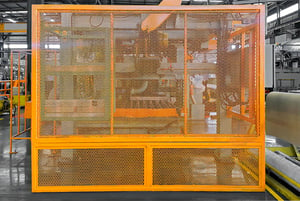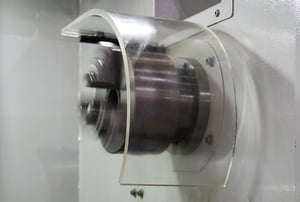 In the manufacturing industry, safety is critically important. With the use of large-scale automated machinery and robotics, having a safety barrier between operators, technicians and the equipment plays a big role in keeping humans safe as they work alongside machines.
In the manufacturing industry, safety is critically important. With the use of large-scale automated machinery and robotics, having a safety barrier between operators, technicians and the equipment plays a big role in keeping humans safe as they work alongside machines.
Guards should prevent contact and not create a hazard. They should also not interfere with machine operations and should be secure and tamper-proof. Let’s look at three common machine perimeter guards that create a safe area around the outside of a machine.
Barrier Guards
According to OSHA, barrier guards are usually the first point-of-operation safeguard considered for machines. Barrier guards can be metal screens, cages or enclosures that create a barrier between a machine and an operator. They can be fixed guards that are permanently in place or they can be adjustable and move based on variations in machine operations. Adjustable guards can also be moved manually by an operator. Fixed guards are safer than adjustable guards when it comes to potential human error causing an accident.
 Light Curtains
Light Curtains
Light curtains are photoelectric devices that use presence detection by bouncing infrared light between a transmitter and receiver. Transmitters send light to receivers and when the photoelectric cells in the receiver stop receiving light, it shows that something is in the way. This interruption information is fed to a safety device that causes a machine shutdown. Light curtains are on constantly and scanning for any interference of the light beam that runs between the transmitter and receiver.
Interlocked Machine Guards
These types of guards are connected to machinery electronically and they regulate operator access to the hazard zone around the machine. When the guard is opened, the machine is automatically shut down.
Some machinery requires workers to be in proximity of potential hazards in order to operate the machine. These machines may have different types of guards that are part of the machine in order to protect operators from hazards. A few examples of these types of guards include lathe guards, drill press or milling machine guards and brake monitors.
 Lathe Guards
Lathe Guards
These types of guards are part of a machine. They are located in areas of the machine where materials move around and their purpose is to protect an operator from flying debris and materials as the equipment is operated.
Drill Press/Milling Machine Guards
These types of guards are designed to fit around machines that require operators to work in close contact with potentially dangerous parts of a machine such as power presses or sharp machine components.
Brake monitors
Brake monitors are non-physical guards. They are sensors that create alerts or shutdowns when machine brake systems are in need of repairs.
Radwell International is your one-stop shop for all industrial automation supplies and services. To learn more visit Radwell.com
Download Your SICK Safety E-book Today

